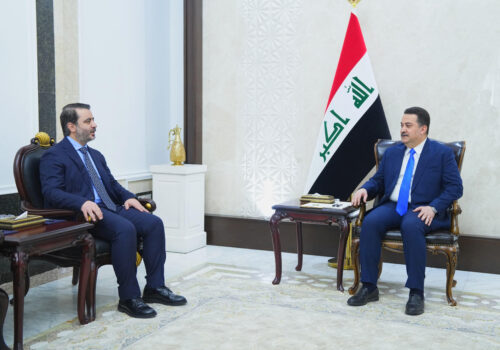Why the US must not let Syria slip away
Amid reports that President Donald Trump and Syrian interim President Ahmed al-Sharaa will meet during Trump’s scheduled May visit to Saudi Arabia, the future of the two new governments’ uneasy relationship should be coming more into focus.
Currently, ideological differences, sanctions, and on-again-off-again tariffs suggest that US policymakers do not share Damascus’s interest in developing US-Syrian economic and security partnerships. If this is the case, the United States would be balking at a generational opportunity to assert American interests in the Middle East. However, if Washington deepens its economic and security engagements with the new Syrian government, the United States could realize historic opportunities to limit Chinese and Russian influence in the Middle East and enfeeble the Iranian Axis of Resistance for years to come.
Better us than them
Without a clear horizon for lifting sanctions and avoiding future tariffs, al-Sharaa’s government is likely to turn to other nations to develop future partnerships, starting with China and Russia.

A bipartisan group of Washington lawmakers has said as much. In mid-February, Republican Senate Foreign Relations Committee Chair Jim Risch warned that limited or no American engagement with the new Syrian government would provide an opening for Russia and Iran to wield substantial influence in Syria again. Likewise, Democratic Senator Jacky Rosen said that the United States cannot allow China and Russia to swoop in and assert their regional interests over the United States.
In the case of China, Jonathan Fulton and Michael Schuman of the Atlantic Council described President Xi Jinping’s recent effort to expand Chinese political, economic, and cultural power in the Middle East as “a campaign to remake the world order and roll back American hegemony.” Not contesting its efforts to expand its influence into Syria would be a major misstep for Washington.
While bolstered Chinese-Syrian relations pose a long-term threat to American influence in the Middle East, Russian presence in Syria poses a more immediate threat to regional stability and US interests.
Russian President Vladimir Putin had been the longstanding economic and security guarantor of the Assad family, thereby ensuring the former regime would do nothing to upset their Russian patrons. Despite the rise of a new government, Russian military presence remains, and presumably, Moscow would be interested in maintaining its clientelist relationship with Damascus. This should be deeply concerning for Washington, particularly as Russian-Iranian ties deepen.
SIGN UP FOR THIS WEEK IN THE MIDEAST NEWSLETTER
But at least so far, enduring sanctions coupled with Trump’s briefly imposed 41 percent tariff on Syria have been unfortunate early signals that Washington’s interest in developing economic relations with post-Bashar al-Assad Damascus is yet to emerge. This posture lacks foresight—investing in Syria as it recovers from a decade of civil war, corruption, and mismanagement may not yield immediate fruit for Washington, but could certainly support its long-term regional interests.
Chiefly, an additional economically stable regional partner, in gratitude to American assistance rather than indebted to Chinese and Russian patronage, would better position the United States to promote regional security and integration while countering Iranian influence.
By lifting sanctions and tariffs and encouraging private investments into the Syrian economy, the United States could offer Damascus a compelling alternative to Chinese and Russian partnerships. Ultimately, crowding China and Russia out of the new Syria would present the United States a generational opportunity that it should be remiss to pass upon.
Don’t be a dumb Axis
The Iranian Axis of Resistance has never been weaker. Syria will be key to keeping it that way.
During the December 2024 collapse of the Assad regime, Iran lost a key strategic ally and the unfettered ability to use Syrian territory to support its destabilizing proxy activities. But Tehran’s regional misfortunes did not end there. Israel’s wars in Gaza and Lebanon have diminished Iran’s capacity to use Hamas and Hezbollah as immediate threats to American regional interests. Even in Iraq, Iran-backed militias have scaled back their strikes on American and Israeli targets, perhaps signaling their fear of drawing Washington’s ire that has recently been directed towards the Houthis in Yemen.
Although this new security landscape favors the United States and its regional allies for the time being, don’t expect it to last, at least not without American encouragement.
Washington’s course of action will play a significant hand in whether the Iranian Axis of Resistance remains weak, and US strategy should include support for Syrian efforts to remove remnants of Tehran’s proxy activity. It seems, at least, that the United States has an ally in al-Shara to those ends, who in interviews has said Iran’s proxies “fuel instability” and pose “a strategic threat to the entire region.”
To find an immediate area for American and Syrian security collaboration, US policymakers should look to the Syrian-Lebanese border, which has been the site of extensive smuggling networks operated by drug cartels and the Iranian-Hezbollah axis.
For decades, these networks existed to enrich, arm, and provide manpower for Iranian regional proxies. From Lebanon to Syria, diesel fuel and the amphetamine narcotic Captagon flowed. From Syria to Lebanon, smugglers trafficked humans and weapons. However, with American logistical and military support, Syrian and Lebanese forces could effectively shut down these illicit smuggling networks, disrupting supply lines crucial to the survival of Iran’s regional proxies, curtailing the harmful Captagon trade, and limiting Iranian support to destabilizing groups.
But opportunities for US-Syrian collaboration could flourish well beyond the Syrian-Lebanese border. With a continued US military presence in Syria, Washington could develop a sustained security partnership with Damascus to eliminate Iranian proxy activity that occurs in and passes through Syria.
However, if the United States does not act, Iranian proxy activity could persist and accelerate. For example, if sustained, Captagon flows would continue to fund violent, destabilizing groups. Weapons and manpower would flow to Hezbollah and other groups in Lebanon and potentially find new homes in Syria, where the central government’s securitization is lacking. In the extreme, these outcomes could produce pockets of lawlessness in Syria, test the endurance of the new Syrian government, and even lead to its collapse.
Washington balking today would dramatically increase the likelihood of these adverse outcomes materializing. Consequently, the chaos and instability emanating from a collapsing state would suck the United States back into Syria. US policymakers should engage Damascus now, when the Iranian Axis of Resistance is at its weakest, rather than in a decade when Iran has again turned Syria into a hotbed of chaos for which they can exploit.
Luke Wagner is a young global professional at the Atlantic Council’s Rafik Hariri Center and Middle East Programs.
Further reading
Tue, Apr 1, 2025
The only viable solution: an independent Syria, not a Turkish protectorate
MENASource By
After a risky bet on the Syrian opposition, Turkey is weighing where to place its bets between dueling visions for the new Syria.
Tue, Apr 1, 2025
Israel is making a miscalculation in southern Syria. Here is why.
MENASource By Ömer Özkizilcik
Israel’s approach in southern Syria risks deepening sectarian divisions, eroding the Druze community’s standin, and fueling broader instability.
Wed, Mar 19, 2025
Why the United States must bridge the Iraq-Syria divide
MENASource By Sarkawt Shamsulddin
With leverage over both capitals, the United States emerges as the linchpin in delicate diplomatic moment between Baghdad and Damascus.
Image: A man carries his belongings while walking near the sea, as Syria's interim President Ahmed al-Sharaa grapples with the fallout from reported mass killings of Alawite minority members, in Latakia, Syria March 11, 2025. REUTERS/Karam al-Masri



